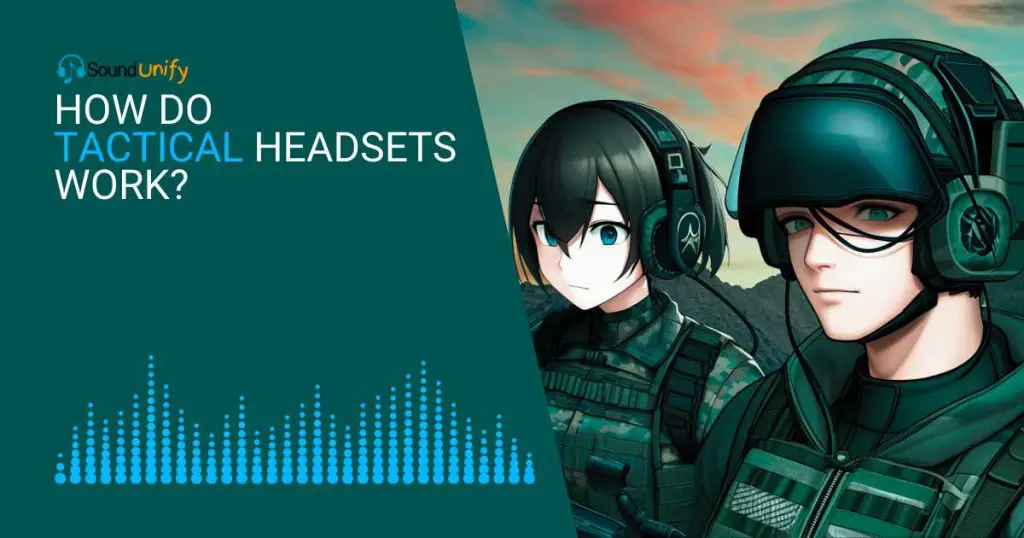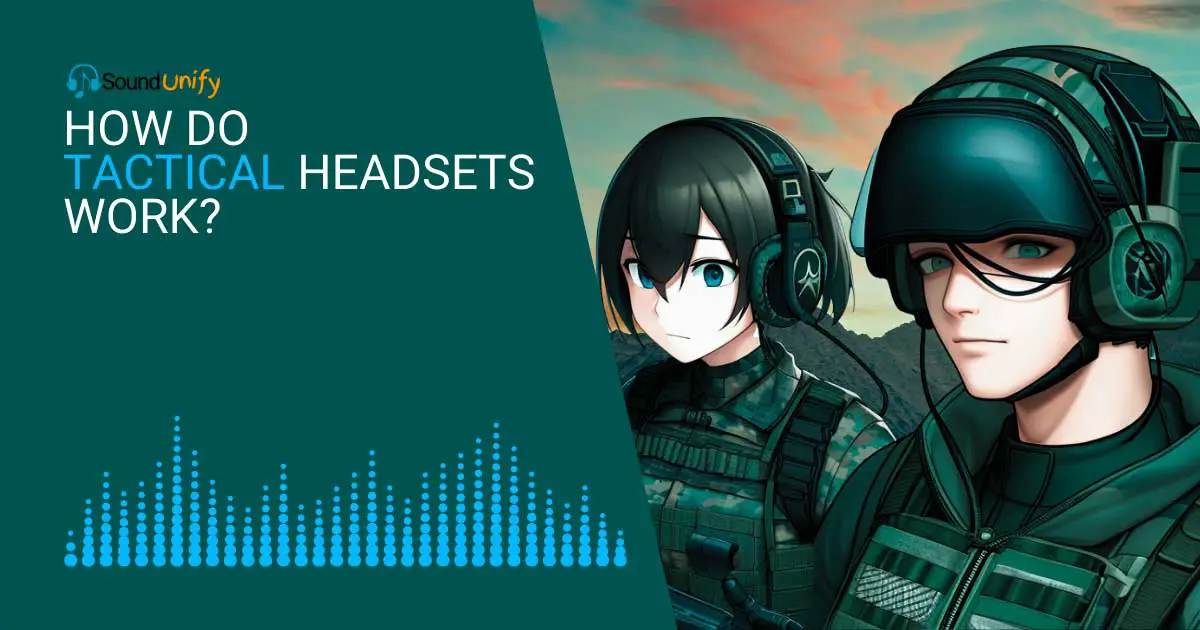Tactical headsets are a type of specialized headset designed for use in high-risk and military operations. These headsets offer superior audio quality, comfort, and durability, making them an ideal choice.
Those who need reliable communications equipment in hazardous or potentially hostile environments.
But how do tactical headsets work? Tactical headsets are designed to allow for clear communication in loud or stressful environments. They use noise-cancelling technology to reduce background noise and have built-in microphones that enable hands-free conversations. Most headsets also feature a volume control that can adjust to suit the environment.
In this article, we’ll explore the features of tactical headsets and how they can benefit general users and those involved in military operations.
What Are Tactical Headsets?
Tactical headsets are specialized communication devices used primarily by military and law enforcement personnel and other first responders for operations in the field.
They design to provide superior sound quality and clarity of communication, with noise-cancelling capabilities to reduce interference from external sources.
Tactical headsets offer a variety of features, such as clear voice transmission and reception, noise-cancellation technology, comfort, and durability.
Tactical headsets typically come in two styles:
Earbud-style headsets are lightweight and discreet, with an unobtrusive design that allows users to carry out their duties without any distractions or attention drawn to them.
Over-ear style headsets are heavier but offer better sound quality by sealing off the ears from outside noise sources. The microphone on a tactical headset is usually adjustable so users can reposition it for optimal sound reception.
Open-ear designs allow users to hear their environment while wearing them. These headsets typically feature adjustable volume controls so users can adjust their listening levels as needed. This headset style is popular among law enforcement officers and military personnel who must remain aware of their surroundings while communicating with others.
Bone conduction technology is another popular option among tactical headset users. This technology transmits sound vibrations through the human skull directly into the inner ear. This technological advancement allows users to communicate effectively without covering their ears with a traditional headset design.
How Do Tactical Headsets Work?

Tactical headsets, also known as intercom or communication headsets, are essential pieces of equipment used by the military, police, and other emergency personnel. In hostile circumstances, they aim to provide clear and dependable communication.
Generally, tactical headsets have two components:
- Receiver
- Microphone
The receiver is designed to receive audio signals from an external source, such as radio or other devices.
It is usually connected to headphones with an adjustable sound output level that allows users to adjust the volume according to their environment.
The microphone captures sound signals amplified and sent to a processor, where they are filtered out and adjusted for clarity before being transmitted as Clean Speech Signals (CSS) over the airwaves or other mediums.
These signals are sent to the receiver’s speaker via an amplifier. The speaker then plays back the audio signal for the user to hear.
Tactical headsets also feature Frequency Hopping Spread Spectrum (FHSS) technology, which helps minimize interference from other wireless devices by hopping among frequencies at a rapid rate.
FHSS can transmit data securely by constantly changing frequencies within predetermined frequencies approved by regulatory bodies such as the FCC or ICASA for transmission between two or more parties.
The headsets often incorporate Bluetooth technology, connecting multiple devices simultaneously, such as an earpiece, a mobile phone, and a laptop computer.
Bluetooth works by assigning each device its unique frequency so they can all talk without interference from other wireless devices nearby.
This ensures clear communication even in crowded environments or when multiple people try to use their gadgets simultaneously.
Features of Tactical Headsets
Tactical headsets come with various features that allow them to be used in many situations. The most common features include noise cancellation, two-way radio communication, and wireless capabilities.
Noise cancellation is a necessary characteristic of tactical headsets since it allows you to listen to sound entering your ears while suppressing background noise. This allows for greater focus and concentration on the task without distractions. This also helps protect your hearing from any potential long-term damage from loud noises.
Two-way radio communication is another excellent feature of tactical headsets. It allows users to communicate with each other over a direct line without relying on cell phone networks or other public networks. This makes it easier to keep up with orders and instructions while on the field or during a mission, ensuring everyone is on the same page.
Wireless capabilities are also beneficial regarding tactical headsets, as they allow freedom of movement without wires getting in the way or becoming tangled. This allows for maximum mobility and flexibility during operations, ensuring that all team members remain connected no matter how far apart they may be.
These are some of the most important features that tactical headsets can offer, but there are many more, depending on which model you choose. Each headset has unique characteristics, so research and find one that best suits your needs.
Who Uses Tactical Headsets?

Tactical headsets are used by various people, ranging from law enforcement and military personnel to hunters and other outdoor enthusiasts. These headsets provide the user with clear audio and reliable performance in even the most demanding environments.
- Law enforcement officers often rely on tactical headsets when working in noisy or dangerous situations. The headsets allow them to stay in communication with their team while maintaining their focus on their surroundings. Tactical headsets also help to reduce fatigue during long shifts, as they are designed with comfort and ergonomics in mind.
- Military personnel also use tactical headsets for many of the same reasons. The headsets can be used in training operations and combat zones, where clear communication is essential for mission success. Tactical headsets also boast noise cancellation capabilities, allowing soldiers to clearly hear instructions without worrying about background noise like gunfire or explosions.
- Outdoor enthusiasts such as hunters and off-roaders may also find tactical headsets useful due to their rugged design and water-resistant features. These features ensure that the headset will remain functional even in wet or dusty conditions, making them perfect for adventurers who like to push the limits of exploration.
Overall, tactical headsets are versatile pieces of equipment that can be used by anyone who needs a reliable way to communicate in challenging situations.
Whether you’re a law enforcement officer protecting your community or an outdoor enthusiast looking for an adventure, you can trust that a tactical headset will keep you connected no matter what comes your way.
7 Reasons Why Use a Tactical Headset?
A tactical headset provides numerous advantages for the user, from improved situational awareness to enhanced communication capabilities.
With a good-quality tactical headset, users can have confidence in their ability to hear their surroundings and effectively communicate with others.
7 Surprising Benefits of Tactical Headsets:
1. Increased situational awareness
Tactical headsets can help you improve your situational awareness. By wearing a headset, you can hear what is happening around you without taking your eyes off the task.
This can be especially helpful in dangerous situations. It can also help you avoid getting into dangerous confrontations.
2. Reduced stress
Tactical headsets are becoming increasingly popular for a variety of reasons. Not only do they reduce stress, but they also improve concentration and focus.
In addition, tactical headsets can help you stay organized and make better decisions during chaotic times. They can also enhance your communication skills and protect your hearing.
3. Improved communication
Tactical headsets are a great way to improve your communication. They allow you to hear what is said in noisy environments, such as construction sites or factories. This can help you to avoid accidents and make more effective decisions.
Tactical headsets provide privacy when needed, allowing you to discuss delicate matters confidently.
4. Enhanced productivity
Tactical headsets are often thought of as a way to enhance productivity in the workplace. However, there are other surprising benefits to using tactical headsets when working.
For example, they can help you stay focused and organized. They also protect your hearing from loud noises, which can be helpful if you work in an environment with a lot of noise.
5. Reduced strain on the neck and eyes
They are becoming more popular because they offer some surprising benefits. For example, tactical headsets reduce strain on the neck and eyes.
This is because they allow you to wear the headset for extended periods without feeling pain or fatigue. Tactical headsets also provide better sound quality than traditional headphones.
They are ideal for video gaming and other activities requiring close attention to detail.
6. Improved listening ability
Tactical headsets are often viewed as tools for military personnel and law enforcement officers. However, they have many other surprising benefits that can be useful in everyday life.
For example, tactical headsets can improve your listening ability. When wearing a headset, the ambient noise is blocked out, allowing you to hear better in crowded or noisy environments.
This can be beneficial when trying to listen to someone speaking close to your ear or focusing on a task that requires concentration.
7. Increased safety while driving
Tactical headsets offer several surprising benefits when it comes to safety while driving. You can increase your situational awareness while driving by wearing a tactical headset.
This means you can hear potential danger before it happens and take appropriate action. Tactical headsets also protect your eyes from glare and harsh sunlight.
Features to Look for When Selecting a Tactical Headset

When selecting a tactical headset, there are many features to consider. Knowing which elements are essential in a headset can help you choose the best one for your needs.
The following are some essential features to consider when selecting a tactical headset.
- Durability: Tactical headsets must withstand rugged conditions and harsh environments. Look for headsets with abrasion-resistant materials like Kevlar or Nomex and water-resistant and dustproof construction. Also, ensure your headset has tough hinges and connectors that won’t break easily.
- Sound Quality: Ensure your headset provides excellent sound quality with clear audio on both ends of the connection. Look for headsets that feature noise-canceling technology, which reduces background noise and improves speech intelligibility so you can hear what anyone says.
- Comfort: Tactical headsets should be comfortable enough to wear for long periods without causing discomfort or fatigue. Look for headsets with adjustable headbands and padded ear cups designed to fit comfortably on your head. Also, check if the headset has a flexible microphone boom that can be moved up or down, depending on your preference.
- Range: The range of a tactical headset is significant, especially if you plan on using it in remote locations or large areas where communication is key. Look for headsets with long-range capabilities to communicate over greater distances without worrying about losing signal strength due to interference or other issues.
- Battery Life: A good tactical headset should have a battery life of at least 8 hours, preferably 12 hours or more, so you can use it all day without worrying about running out of power mid-mission. Some models feature rechargeable batteries, while others require AA batteries.
Popular Brands of Tactical Headsets
When it comes to tactical headsets, there are a few top brands that stand out. The most popular tactical headset brands include Silynx Communications, Peltor, and Etymotic Research.
These companies offer quality headsets with excellent audio quality and noise cancellation technology.
- Peltor tactical headsets from 3M. These headsets are designed for military personnel and law enforcement officers and feature noise-cancelling microphones, low-profile ear cups for a secure fit, and adjustable headbands for maximum comfort. They also have built-in radio adaptors so users can easily connect their devices to compatible radios and communication systems.
- Silynx Communications produces a range of cutting-edge tactical headsets specifically designed for use in hazardous environments. These headsets offer superior sound quality and features such as Bluetooth technology for easy connection with other devices or communication systems. They also come with an ergonomic design, so they can be worn comfortably for extended periods without causing fatigue or discomfort.
FAQ
Why do soldiers wear headphones?
Special soldiers typically wear headsets with microphones and volume controls to help facilitate communication in noisy environments, such as when in combat or during hostage-rescue operations.
Headsets allow for more accessible communication between team members without speaking loudly. Additionally, headsets let special forces talk on the radio or other communication systems without being heard by their targets.
What headset does the US military use?
The US military typically uses the Lightweight Headset (LWH) and the Modular Integrated Communications Helmet (MICH). The LWH is a lightweight, low-profile headset that provides a microphone, an earpiece, and volume control.
The MICH is a more robust device that offers improved audio quality, digital programming capability, and other features.
Do Soldiers Wear Ear Protection in Battle?
Yes, soldiers will often wear earplugs or ear muffs in certain situations to protect against the sound of gunfire and explosions.
Additionally, you may wear hearing protection during certain operations to reduce the risk of hearing damage caused by high-decibel noises.
What Does a Tactical Headset Do?
A tactical headset provides the user with communication, hearing protection, and situational awareness.
The headsets have specialized features such as noise reduction, voice amplification, radio compatibility, and detecting sound direction.
Also, the headset may come with computer-aided devices such as direction-finding and facial recognition systems.
Conclusion
Tactical headsets are a great choice for anyone that requires a reliable headset. They provide excellent sound quality, comfort, convenience, and secure communications capabilities.
With the wide variety of features available, you can find the right tactical headset for your specific needs. Whether you’re looking for a secure communication device or need something comfortable to wear for long periods, there’s sure to be an option that suits your needs.
When choosing the best tactical headset for yourself, carefully consider all the features and benefits to get the most out of your purchase.
James Dimento is a Chief-in-Editor of SoundUnify. He is a headphone enthusiast and creative writer passionate about audio technology. He has three years of experience writing about headphones and sound quality and is responsible for creating reviews and taking care of all administration.
